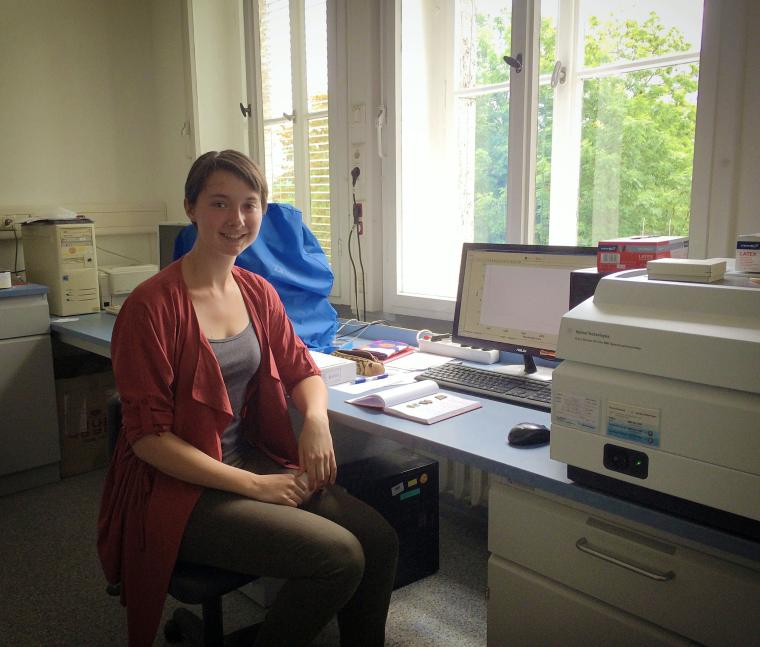Summer Research Around the World
August 22, 2016
Justine Goode

Third-year Emilie Lozier with a UV-vis spectrometer at the Otto Schott Materials Science Institute (OSIM) in Jena, Germany.
Photo credit: Emilie Lozier
During the academic year, Oberlin students stay impressively busy, committing to a spectrum of organizations and obligations without blinking an eye. Full course load? Check. Extracurriculars? Check. Co-op crew? Work-study shift? Check, check. So perhaps it comes as no surprise that even during the summer, students seek opportunities to pursue their academic interests and delve deeper into their fields of study.
This year, more than 80 students are conducting research around the country and the world, with many projects funded by programs or fellowships such as the National Science Foundation’s Research Experiences for Undergraduates (REU), the EPA’s Greater Research Opportunities (GRO), the Howard Hughes Medical Institute’s Exceptional Research Opportunities Program (EXROP), and the XARTS Grant.
Rising fourth-year Jenna Bellassai is using a Research Experience for Undergraduates (REU) to innovatively combine her English major and computer science minor. Bellassai is working as a programmer on the "Data-Driven Interactive Narrative Engine" (DINE), an interactive storytelling web application being developed at the University of Southern California. “DINE is like those ‘choose your own adventure’ books with a twist,” Bellassai says. “When you visit the website, the beginning of a story comes up, you type in what you would do next, and the story continues based on what you wrote.” Bellassai is working on a part of the application that chooses what will happen after a user types something in, and collaborates with a team of six interns at the Institute for Creative Technologies at USC. Her day-to-day responsibilities include experimenting with unsupervised and supervised methods of text classification—“basically programming and testing out new ways for the site to decide what to do based on user input,” she says.
Emilie Lozier, a rising third-year, is currently working at the Otto Schott Materials Science Institute (OSIM) in Jena, Germany, running spectroscopic analyses on shards of stained glass from a 14th-century church to help determine their chemical composition. With its rich history in glass and optics, Jena is one of the world’s foremost hubs of optical research, and is also a bustling city full of students and young families. In addition to her everyday duties in the lab, which include taking measurements of the medieval glass shards using a UV-vis spectrometer, Lozier says she has greatly enjoyed getting to know the city. “This is my first time being abroad for such a long period of time, so unsurprisingly my life has become both exhausting and exciting,” Lozier says.
Having taken only a semester of German at Oberlin, she admits the language barrier can sometimes be stressful, but after several weeks on the job, she is beginning to settle in. “I’m happy to have another six weeks to get to know the area even better,” she says. “Not to mention I have the whole of Europe at my disposal on the weekends.” Lozier’s work at OSIM is made possible through the Deutscher Akademischer Austauschdienst (DAAD), which every summer provides 300 undergraduate students from the United States, the United Kingdom, and Canada with stipended research internships at universities and research institutions all over Germany.
Anthony Moaton, a rising fourth-year, is a Mellon Mays Undergraduate Fellow. As part of his fellowship, he is conducting research at the University of Chicago’s Summer Research Training Program (SRTP). This research will ultimately serve as his capstone for his individual major in performance studies. Moaton’s project was inspired by his work as a Bonner Scholar, as he wanted to find a way to combine civic engagement with academics. He will be working with youth in Oberlin through a local organization called the Oberlin Youth Project to develop a "Living Newspaper" for youth to share their concerns about their place in the Oberlin community. “The Living Newspaper is a form of theater that was very popular during the Great Depression as part of the Federal Theater Project, the only time there was federally funded theater in this country,” Moaton says. “It allowed people of all backgrounds to be paid to research social issues, turn that research into a script, and perform the script for their communities.
"I want to examine how the process of doing that type of political performance will assist or hinder youth from gaining political power in a town that's attempting to fix its town-college divide," he says. In addition to his research at UChicago, Moaton is taking a full course load, which includes Writing for Research, Engaged Scholarship, and U.S. Social Histories. The program provides students with transit cards and organizes outings throughout Chicago.
“As someone who is from a suburb of Chicago and has been at Oberlin every summer and winter since I first came to Oberlin, I am very happy to be back home and gain new experiences, while garnering a different type of appreciation for what Oberlin has offered me for the past three years,” Moaton says.
Other student research projects include studying the genetic disease Congenital Dyserythropoietic Anemia type II, processing photos of bovidae skulls at the American Museum of Natural History in New York, working in the Language and Cognition lab at Stanford University, and helping build a muon (subatomic particle) detector to image the inside of the Santa Maria del Fiore dome in Florence, Italy.
You may also like…
Josh Nolan Named Vice President, General Counsel, and Secretary at Oberlin
Distinguished attorney brings extensive experience in higher education law.
Learning by Teaching: Oberlin Students Share Global Music with Young Learners
College and Conservatory students in PACE 103 prepare local children for an immersive community concert at Oberlin.
Nuiko Wadden ’02 Joins Oberlin Conservatory Faculty as Assistant Professor of Harp
The versatile musician brings extensive opera, orchestral, and contemporary music experience to her role


